Network Security Analysis Report: ITECH1102 Weeks 1-7 Overview
VerifiedAdded on 2022/11/28
|7
|2129
|397
Report
AI Summary
This report provides an analysis of network security, covering the concepts discussed in the ITECH1102 course across seven weeks. It begins with an overview of basic networking concepts, including data exchange, number systems (binary, decimal, hexadecimal), and the technologies involved. The report then delves into the operation of networking hardware, different network types (home, campus, internet), and the comparison of the Internet Model and OSI reference model. Subsequent sections analyze the Application Layer, Data Link Layer, Network Layer, Transport Layer, and Physical Layer, detailing their respective functions, protocols (TCP, UDP), and technologies. The report explores packet switching, IP addressing, routing, and the roles of routers, MAC addresses, and various multiplexing techniques. Key topics include application architectures, network interface cards, Ethernet frames, IP addresses, and the three-way handshake, providing a comprehensive understanding of network security principles. The report also provides a discussion on the importance of the transport layer, the role of port numbers, and the concept of stateless protocols. Finally, the report concludes with an overview of the physical layer.

Running head: NETWORK AND SECURITY
NETWORK AND SECURITY
Name of the Student
Name of the Organization
Author Note
NETWORK AND SECURITY
Name of the Student
Name of the Organization
Author Note
Paraphrase This Document
Need a fresh take? Get an instant paraphrase of this document with our AI Paraphraser
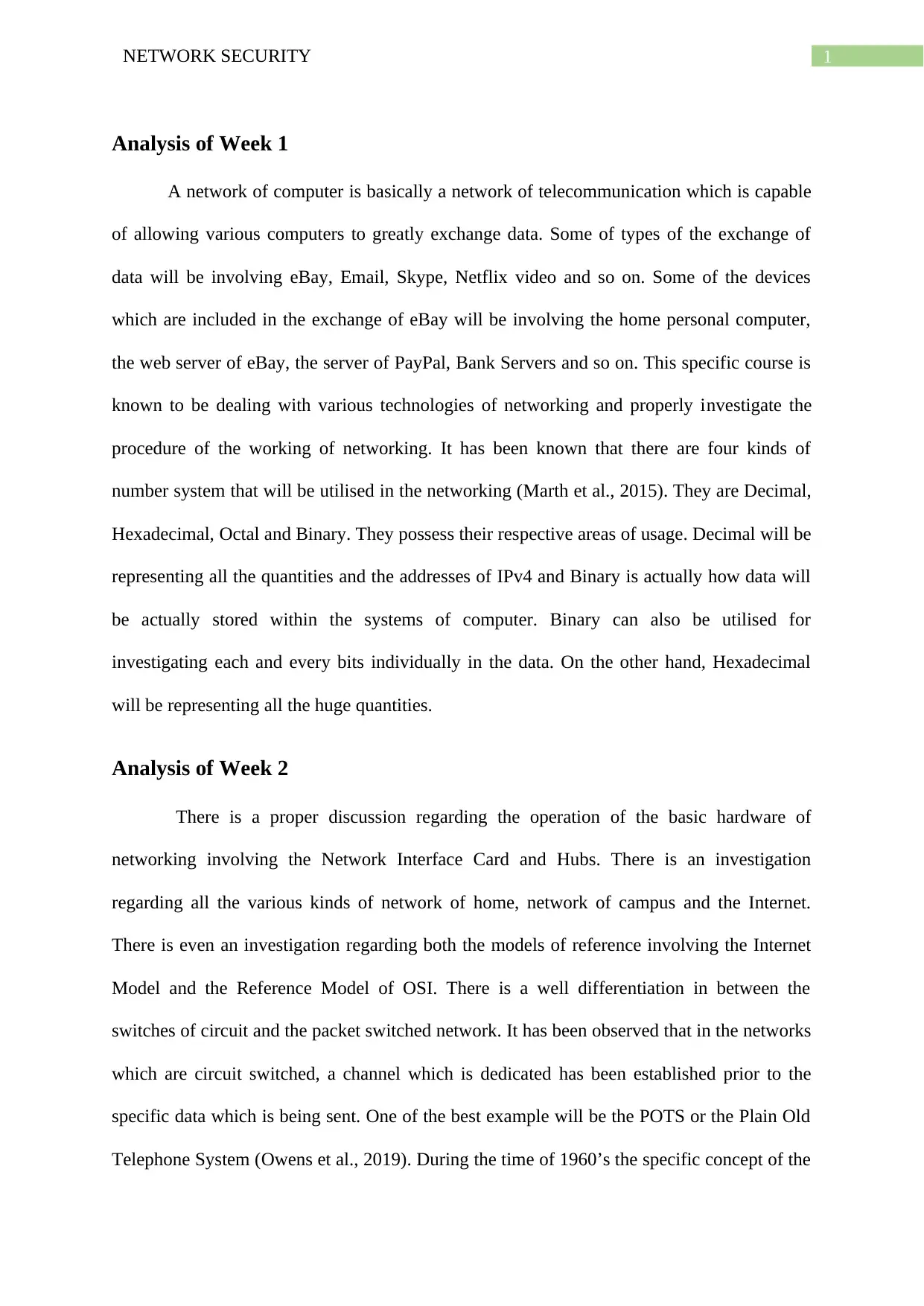
1NETWORK SECURITY
Analysis of Week 1
A network of computer is basically a network of telecommunication which is capable
of allowing various computers to greatly exchange data. Some of types of the exchange of
data will be involving eBay, Email, Skype, Netflix video and so on. Some of the devices
which are included in the exchange of eBay will be involving the home personal computer,
the web server of eBay, the server of PayPal, Bank Servers and so on. This specific course is
known to be dealing with various technologies of networking and properly investigate the
procedure of the working of networking. It has been known that there are four kinds of
number system that will be utilised in the networking (Marth et al., 2015). They are Decimal,
Hexadecimal, Octal and Binary. They possess their respective areas of usage. Decimal will be
representing all the quantities and the addresses of IPv4 and Binary is actually how data will
be actually stored within the systems of computer. Binary can also be utilised for
investigating each and every bits individually in the data. On the other hand, Hexadecimal
will be representing all the huge quantities.
Analysis of Week 2
There is a proper discussion regarding the operation of the basic hardware of
networking involving the Network Interface Card and Hubs. There is an investigation
regarding all the various kinds of network of home, network of campus and the Internet.
There is even an investigation regarding both the models of reference involving the Internet
Model and the Reference Model of OSI. There is a well differentiation in between the
switches of circuit and the packet switched network. It has been observed that in the networks
which are circuit switched, a channel which is dedicated has been established prior to the
specific data which is being sent. One of the best example will be the POTS or the Plain Old
Telephone System (Owens et al., 2019). During the time of 1960’s the specific concept of the
Analysis of Week 1
A network of computer is basically a network of telecommunication which is capable
of allowing various computers to greatly exchange data. Some of types of the exchange of
data will be involving eBay, Email, Skype, Netflix video and so on. Some of the devices
which are included in the exchange of eBay will be involving the home personal computer,
the web server of eBay, the server of PayPal, Bank Servers and so on. This specific course is
known to be dealing with various technologies of networking and properly investigate the
procedure of the working of networking. It has been known that there are four kinds of
number system that will be utilised in the networking (Marth et al., 2015). They are Decimal,
Hexadecimal, Octal and Binary. They possess their respective areas of usage. Decimal will be
representing all the quantities and the addresses of IPv4 and Binary is actually how data will
be actually stored within the systems of computer. Binary can also be utilised for
investigating each and every bits individually in the data. On the other hand, Hexadecimal
will be representing all the huge quantities.
Analysis of Week 2
There is a proper discussion regarding the operation of the basic hardware of
networking involving the Network Interface Card and Hubs. There is an investigation
regarding all the various kinds of network of home, network of campus and the Internet.
There is even an investigation regarding both the models of reference involving the Internet
Model and the Reference Model of OSI. There is a well differentiation in between the
switches of circuit and the packet switched network. It has been observed that in the networks
which are circuit switched, a channel which is dedicated has been established prior to the
specific data which is being sent. One of the best example will be the POTS or the Plain Old
Telephone System (Owens et al., 2019). During the time of 1960’s the specific concept of the
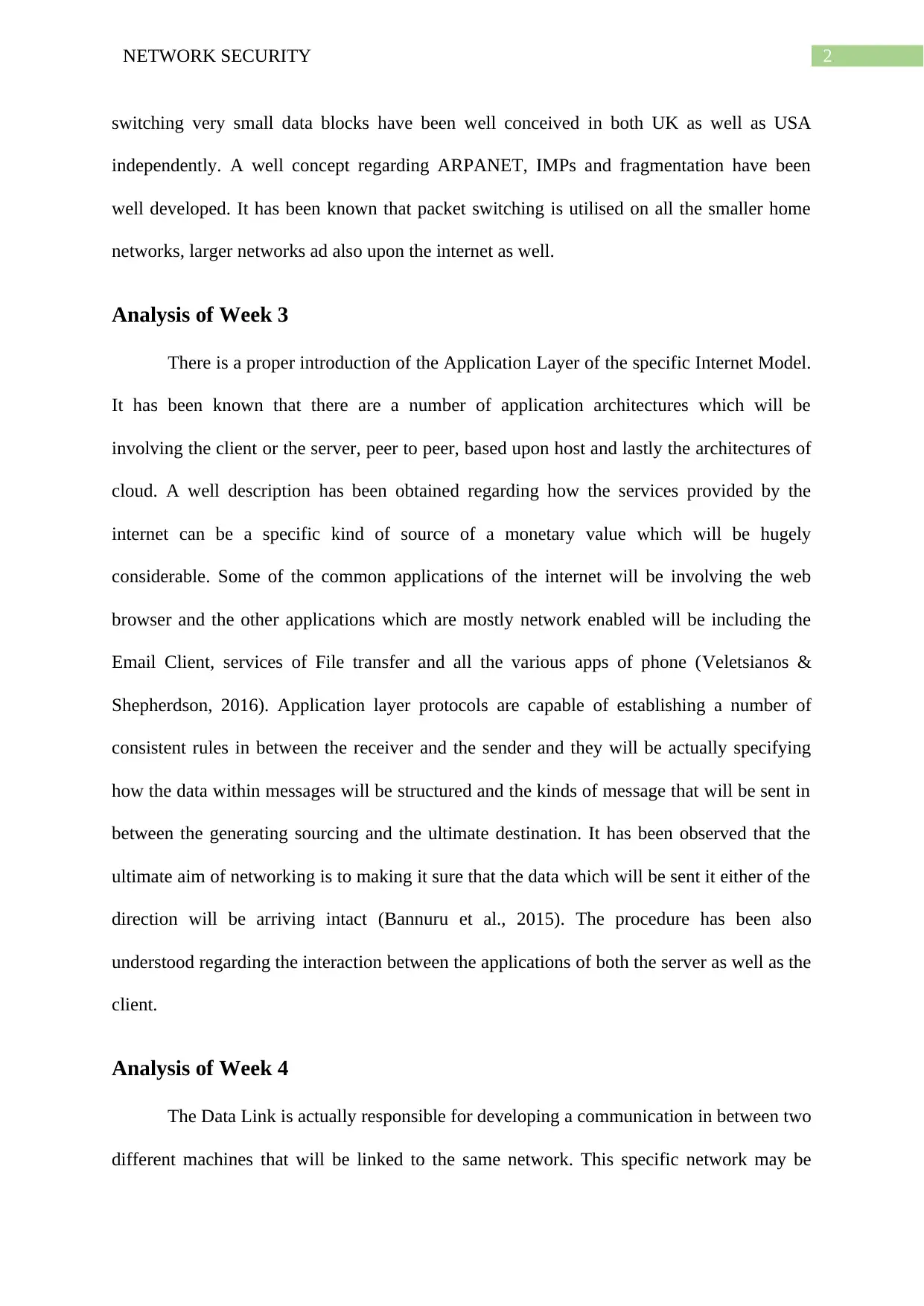
2NETWORK SECURITY
switching very small data blocks have been well conceived in both UK as well as USA
independently. A well concept regarding ARPANET, IMPs and fragmentation have been
well developed. It has been known that packet switching is utilised on all the smaller home
networks, larger networks ad also upon the internet as well.
Analysis of Week 3
There is a proper introduction of the Application Layer of the specific Internet Model.
It has been known that there are a number of application architectures which will be
involving the client or the server, peer to peer, based upon host and lastly the architectures of
cloud. A well description has been obtained regarding how the services provided by the
internet can be a specific kind of source of a monetary value which will be hugely
considerable. Some of the common applications of the internet will be involving the web
browser and the other applications which are mostly network enabled will be including the
Email Client, services of File transfer and all the various apps of phone (Veletsianos &
Shepherdson, 2016). Application layer protocols are capable of establishing a number of
consistent rules in between the receiver and the sender and they will be actually specifying
how the data within messages will be structured and the kinds of message that will be sent in
between the generating sourcing and the ultimate destination. It has been observed that the
ultimate aim of networking is to making it sure that the data which will be sent it either of the
direction will be arriving intact (Bannuru et al., 2015). The procedure has been also
understood regarding the interaction between the applications of both the server as well as the
client.
Analysis of Week 4
The Data Link is actually responsible for developing a communication in between two
different machines that will be linked to the same network. This specific network may be
switching very small data blocks have been well conceived in both UK as well as USA
independently. A well concept regarding ARPANET, IMPs and fragmentation have been
well developed. It has been known that packet switching is utilised on all the smaller home
networks, larger networks ad also upon the internet as well.
Analysis of Week 3
There is a proper introduction of the Application Layer of the specific Internet Model.
It has been known that there are a number of application architectures which will be
involving the client or the server, peer to peer, based upon host and lastly the architectures of
cloud. A well description has been obtained regarding how the services provided by the
internet can be a specific kind of source of a monetary value which will be hugely
considerable. Some of the common applications of the internet will be involving the web
browser and the other applications which are mostly network enabled will be including the
Email Client, services of File transfer and all the various apps of phone (Veletsianos &
Shepherdson, 2016). Application layer protocols are capable of establishing a number of
consistent rules in between the receiver and the sender and they will be actually specifying
how the data within messages will be structured and the kinds of message that will be sent in
between the generating sourcing and the ultimate destination. It has been observed that the
ultimate aim of networking is to making it sure that the data which will be sent it either of the
direction will be arriving intact (Bannuru et al., 2015). The procedure has been also
understood regarding the interaction between the applications of both the server as well as the
client.
Analysis of Week 4
The Data Link is actually responsible for developing a communication in between two
different machines that will be linked to the same network. This specific network may be
⊘ This is a preview!⊘
Do you want full access?
Subscribe today to unlock all pages.

Trusted by 1+ million students worldwide
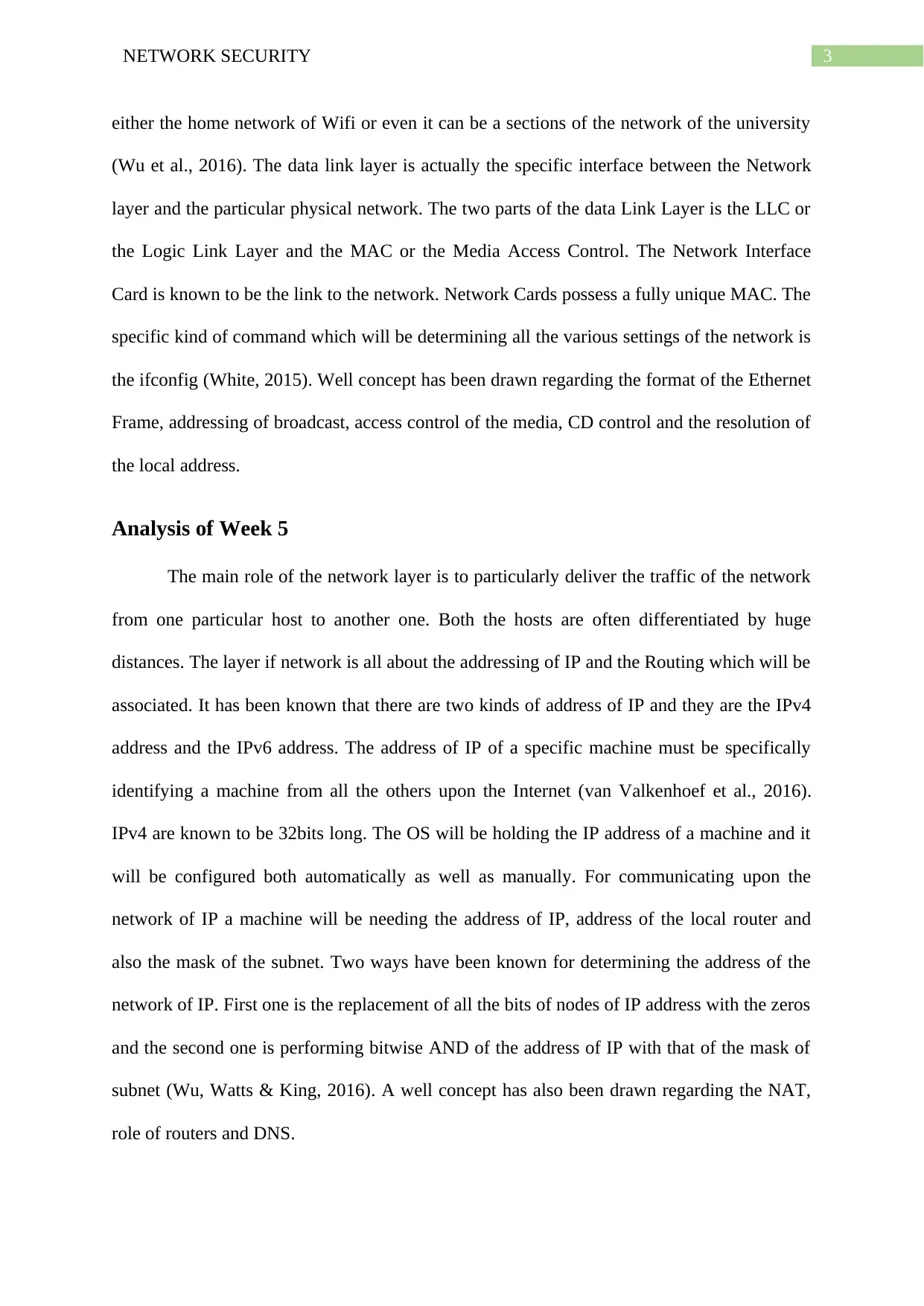
3NETWORK SECURITY
either the home network of Wifi or even it can be a sections of the network of the university
(Wu et al., 2016). The data link layer is actually the specific interface between the Network
layer and the particular physical network. The two parts of the data Link Layer is the LLC or
the Logic Link Layer and the MAC or the Media Access Control. The Network Interface
Card is known to be the link to the network. Network Cards possess a fully unique MAC. The
specific kind of command which will be determining all the various settings of the network is
the ifconfig (White, 2015). Well concept has been drawn regarding the format of the Ethernet
Frame, addressing of broadcast, access control of the media, CD control and the resolution of
the local address.
Analysis of Week 5
The main role of the network layer is to particularly deliver the traffic of the network
from one particular host to another one. Both the hosts are often differentiated by huge
distances. The layer if network is all about the addressing of IP and the Routing which will be
associated. It has been known that there are two kinds of address of IP and they are the IPv4
address and the IPv6 address. The address of IP of a specific machine must be specifically
identifying a machine from all the others upon the Internet (van Valkenhoef et al., 2016).
IPv4 are known to be 32bits long. The OS will be holding the IP address of a machine and it
will be configured both automatically as well as manually. For communicating upon the
network of IP a machine will be needing the address of IP, address of the local router and
also the mask of the subnet. Two ways have been known for determining the address of the
network of IP. First one is the replacement of all the bits of nodes of IP address with the zeros
and the second one is performing bitwise AND of the address of IP with that of the mask of
subnet (Wu, Watts & King, 2016). A well concept has also been drawn regarding the NAT,
role of routers and DNS.
either the home network of Wifi or even it can be a sections of the network of the university
(Wu et al., 2016). The data link layer is actually the specific interface between the Network
layer and the particular physical network. The two parts of the data Link Layer is the LLC or
the Logic Link Layer and the MAC or the Media Access Control. The Network Interface
Card is known to be the link to the network. Network Cards possess a fully unique MAC. The
specific kind of command which will be determining all the various settings of the network is
the ifconfig (White, 2015). Well concept has been drawn regarding the format of the Ethernet
Frame, addressing of broadcast, access control of the media, CD control and the resolution of
the local address.
Analysis of Week 5
The main role of the network layer is to particularly deliver the traffic of the network
from one particular host to another one. Both the hosts are often differentiated by huge
distances. The layer if network is all about the addressing of IP and the Routing which will be
associated. It has been known that there are two kinds of address of IP and they are the IPv4
address and the IPv6 address. The address of IP of a specific machine must be specifically
identifying a machine from all the others upon the Internet (van Valkenhoef et al., 2016).
IPv4 are known to be 32bits long. The OS will be holding the IP address of a machine and it
will be configured both automatically as well as manually. For communicating upon the
network of IP a machine will be needing the address of IP, address of the local router and
also the mask of the subnet. Two ways have been known for determining the address of the
network of IP. First one is the replacement of all the bits of nodes of IP address with the zeros
and the second one is performing bitwise AND of the address of IP with that of the mask of
subnet (Wu, Watts & King, 2016). A well concept has also been drawn regarding the NAT,
role of routers and DNS.
Paraphrase This Document
Need a fresh take? Get an instant paraphrase of this document with our AI Paraphraser
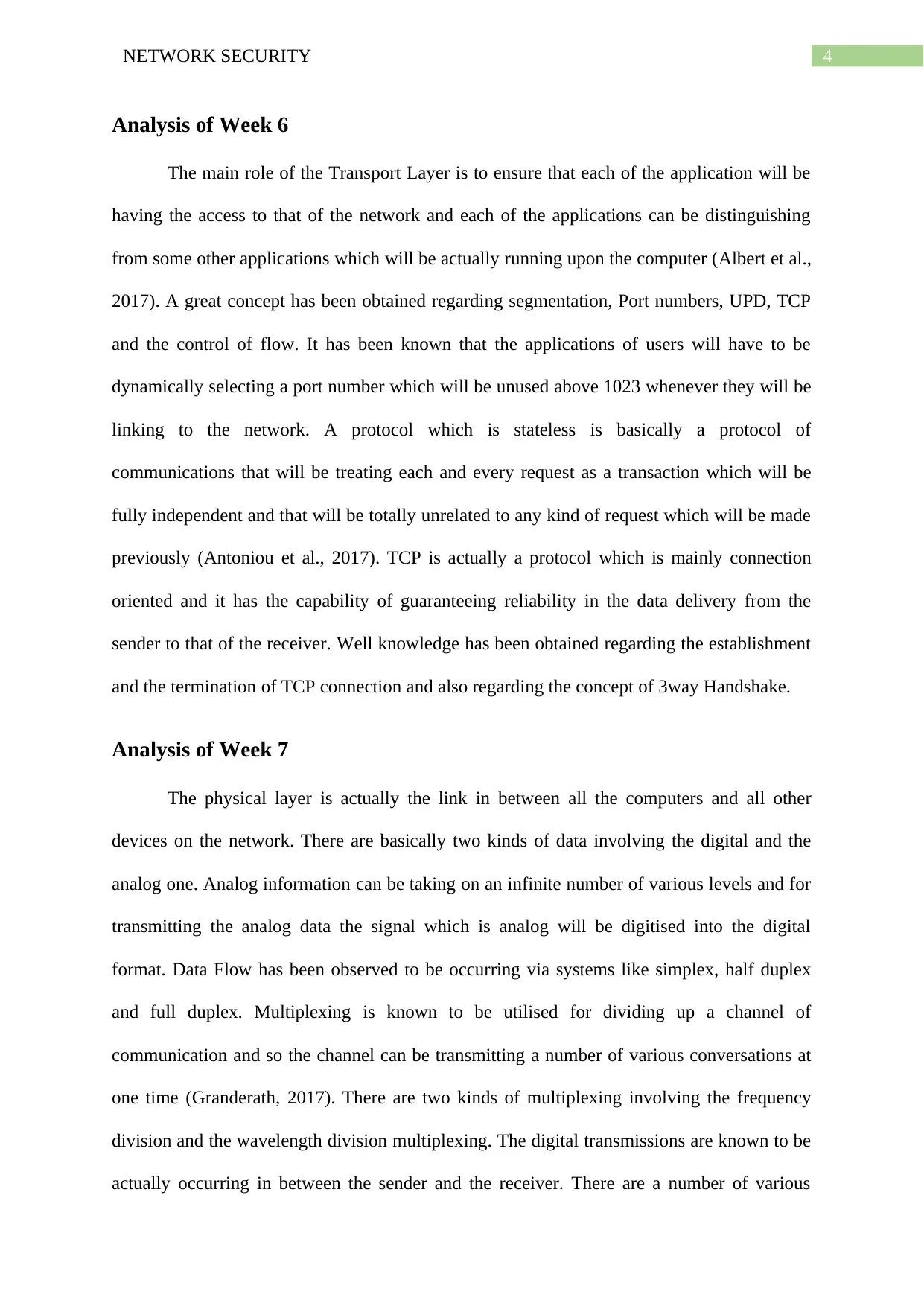
4NETWORK SECURITY
Analysis of Week 6
The main role of the Transport Layer is to ensure that each of the application will be
having the access to that of the network and each of the applications can be distinguishing
from some other applications which will be actually running upon the computer (Albert et al.,
2017). A great concept has been obtained regarding segmentation, Port numbers, UPD, TCP
and the control of flow. It has been known that the applications of users will have to be
dynamically selecting a port number which will be unused above 1023 whenever they will be
linking to the network. A protocol which is stateless is basically a protocol of
communications that will be treating each and every request as a transaction which will be
fully independent and that will be totally unrelated to any kind of request which will be made
previously (Antoniou et al., 2017). TCP is actually a protocol which is mainly connection
oriented and it has the capability of guaranteeing reliability in the data delivery from the
sender to that of the receiver. Well knowledge has been obtained regarding the establishment
and the termination of TCP connection and also regarding the concept of 3way Handshake.
Analysis of Week 7
The physical layer is actually the link in between all the computers and all other
devices on the network. There are basically two kinds of data involving the digital and the
analog one. Analog information can be taking on an infinite number of various levels and for
transmitting the analog data the signal which is analog will be digitised into the digital
format. Data Flow has been observed to be occurring via systems like simplex, half duplex
and full duplex. Multiplexing is known to be utilised for dividing up a channel of
communication and so the channel can be transmitting a number of various conversations at
one time (Granderath, 2017). There are two kinds of multiplexing involving the frequency
division and the wavelength division multiplexing. The digital transmissions are known to be
actually occurring in between the sender and the receiver. There are a number of various
Analysis of Week 6
The main role of the Transport Layer is to ensure that each of the application will be
having the access to that of the network and each of the applications can be distinguishing
from some other applications which will be actually running upon the computer (Albert et al.,
2017). A great concept has been obtained regarding segmentation, Port numbers, UPD, TCP
and the control of flow. It has been known that the applications of users will have to be
dynamically selecting a port number which will be unused above 1023 whenever they will be
linking to the network. A protocol which is stateless is basically a protocol of
communications that will be treating each and every request as a transaction which will be
fully independent and that will be totally unrelated to any kind of request which will be made
previously (Antoniou et al., 2017). TCP is actually a protocol which is mainly connection
oriented and it has the capability of guaranteeing reliability in the data delivery from the
sender to that of the receiver. Well knowledge has been obtained regarding the establishment
and the termination of TCP connection and also regarding the concept of 3way Handshake.
Analysis of Week 7
The physical layer is actually the link in between all the computers and all other
devices on the network. There are basically two kinds of data involving the digital and the
analog one. Analog information can be taking on an infinite number of various levels and for
transmitting the analog data the signal which is analog will be digitised into the digital
format. Data Flow has been observed to be occurring via systems like simplex, half duplex
and full duplex. Multiplexing is known to be utilised for dividing up a channel of
communication and so the channel can be transmitting a number of various conversations at
one time (Granderath, 2017). There are two kinds of multiplexing involving the frequency
division and the wavelength division multiplexing. The digital transmissions are known to be
actually occurring in between the sender and the receiver. There are a number of various
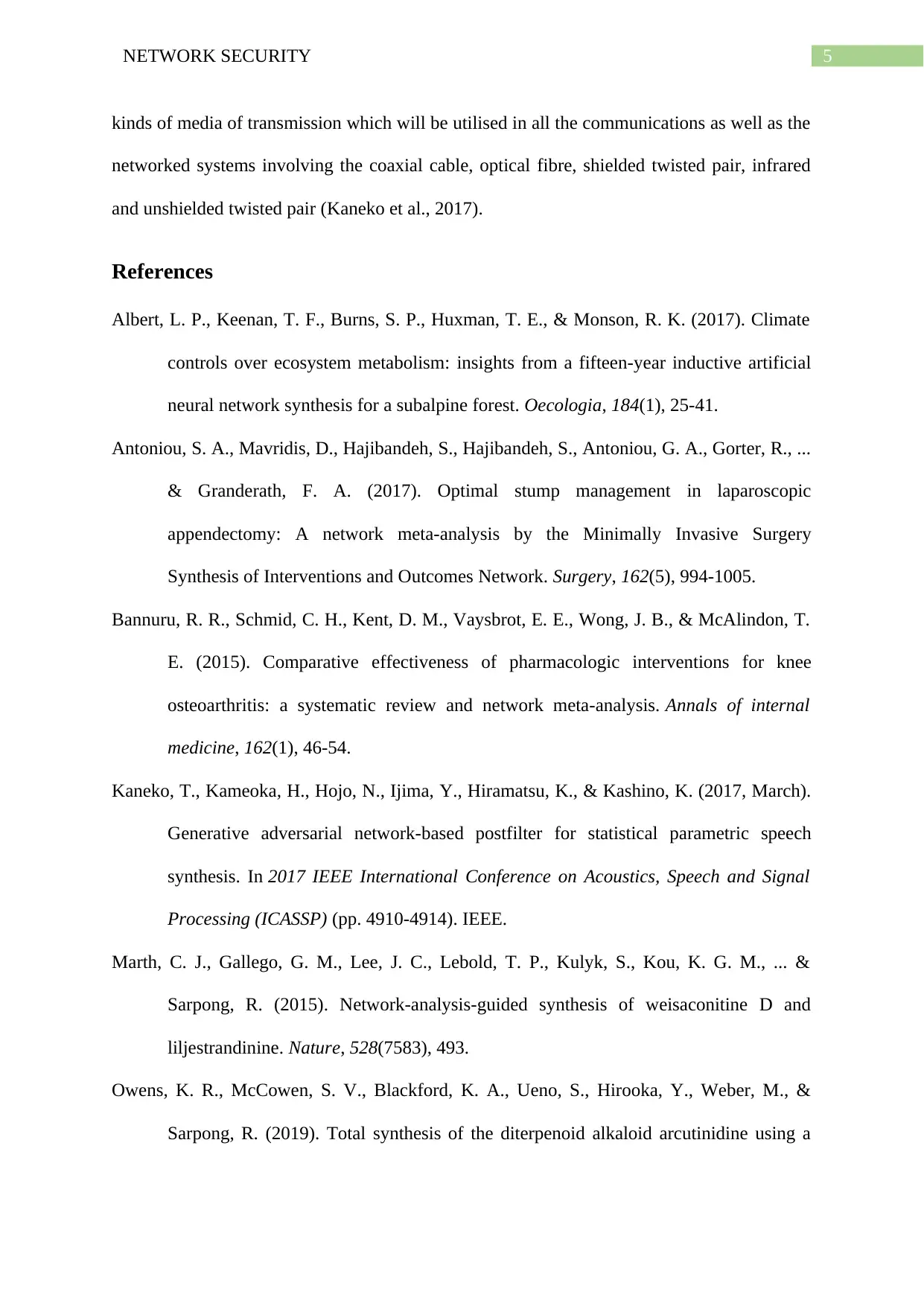
5NETWORK SECURITY
kinds of media of transmission which will be utilised in all the communications as well as the
networked systems involving the coaxial cable, optical fibre, shielded twisted pair, infrared
and unshielded twisted pair (Kaneko et al., 2017).
References
Albert, L. P., Keenan, T. F., Burns, S. P., Huxman, T. E., & Monson, R. K. (2017). Climate
controls over ecosystem metabolism: insights from a fifteen-year inductive artificial
neural network synthesis for a subalpine forest. Oecologia, 184(1), 25-41.
Antoniou, S. A., Mavridis, D., Hajibandeh, S., Hajibandeh, S., Antoniou, G. A., Gorter, R., ...
& Granderath, F. A. (2017). Optimal stump management in laparoscopic
appendectomy: A network meta-analysis by the Minimally Invasive Surgery
Synthesis of Interventions and Outcomes Network. Surgery, 162(5), 994-1005.
Bannuru, R. R., Schmid, C. H., Kent, D. M., Vaysbrot, E. E., Wong, J. B., & McAlindon, T.
E. (2015). Comparative effectiveness of pharmacologic interventions for knee
osteoarthritis: a systematic review and network meta-analysis. Annals of internal
medicine, 162(1), 46-54.
Kaneko, T., Kameoka, H., Hojo, N., Ijima, Y., Hiramatsu, K., & Kashino, K. (2017, March).
Generative adversarial network-based postfilter for statistical parametric speech
synthesis. In 2017 IEEE International Conference on Acoustics, Speech and Signal
Processing (ICASSP) (pp. 4910-4914). IEEE.
Marth, C. J., Gallego, G. M., Lee, J. C., Lebold, T. P., Kulyk, S., Kou, K. G. M., ... &
Sarpong, R. (2015). Network-analysis-guided synthesis of weisaconitine D and
liljestrandinine. Nature, 528(7583), 493.
Owens, K. R., McCowen, S. V., Blackford, K. A., Ueno, S., Hirooka, Y., Weber, M., &
Sarpong, R. (2019). Total synthesis of the diterpenoid alkaloid arcutinidine using a
kinds of media of transmission which will be utilised in all the communications as well as the
networked systems involving the coaxial cable, optical fibre, shielded twisted pair, infrared
and unshielded twisted pair (Kaneko et al., 2017).
References
Albert, L. P., Keenan, T. F., Burns, S. P., Huxman, T. E., & Monson, R. K. (2017). Climate
controls over ecosystem metabolism: insights from a fifteen-year inductive artificial
neural network synthesis for a subalpine forest. Oecologia, 184(1), 25-41.
Antoniou, S. A., Mavridis, D., Hajibandeh, S., Hajibandeh, S., Antoniou, G. A., Gorter, R., ...
& Granderath, F. A. (2017). Optimal stump management in laparoscopic
appendectomy: A network meta-analysis by the Minimally Invasive Surgery
Synthesis of Interventions and Outcomes Network. Surgery, 162(5), 994-1005.
Bannuru, R. R., Schmid, C. H., Kent, D. M., Vaysbrot, E. E., Wong, J. B., & McAlindon, T.
E. (2015). Comparative effectiveness of pharmacologic interventions for knee
osteoarthritis: a systematic review and network meta-analysis. Annals of internal
medicine, 162(1), 46-54.
Kaneko, T., Kameoka, H., Hojo, N., Ijima, Y., Hiramatsu, K., & Kashino, K. (2017, March).
Generative adversarial network-based postfilter for statistical parametric speech
synthesis. In 2017 IEEE International Conference on Acoustics, Speech and Signal
Processing (ICASSP) (pp. 4910-4914). IEEE.
Marth, C. J., Gallego, G. M., Lee, J. C., Lebold, T. P., Kulyk, S., Kou, K. G. M., ... &
Sarpong, R. (2015). Network-analysis-guided synthesis of weisaconitine D and
liljestrandinine. Nature, 528(7583), 493.
Owens, K. R., McCowen, S. V., Blackford, K. A., Ueno, S., Hirooka, Y., Weber, M., &
Sarpong, R. (2019). Total synthesis of the diterpenoid alkaloid arcutinidine using a
⊘ This is a preview!⊘
Do you want full access?
Subscribe today to unlock all pages.

Trusted by 1+ million students worldwide
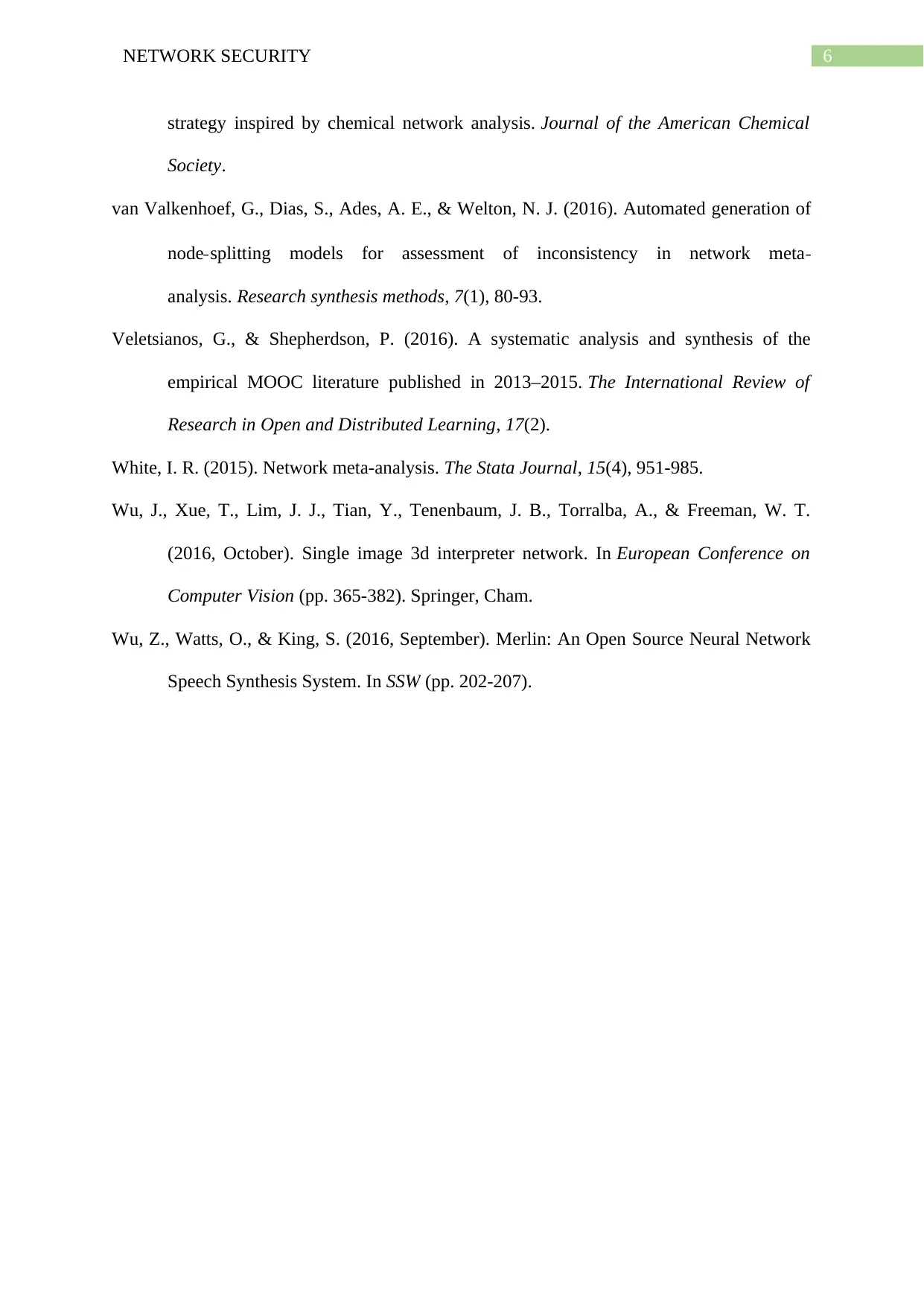
6NETWORK SECURITY
strategy inspired by chemical network analysis. Journal of the American Chemical
Society.
van Valkenhoef, G., Dias, S., Ades, A. E., & Welton, N. J. (2016). Automated generation of
node‐splitting models for assessment of inconsistency in network meta‐
analysis. Research synthesis methods, 7(1), 80-93.
Veletsianos, G., & Shepherdson, P. (2016). A systematic analysis and synthesis of the
empirical MOOC literature published in 2013–2015. The International Review of
Research in Open and Distributed Learning, 17(2).
White, I. R. (2015). Network meta-analysis. The Stata Journal, 15(4), 951-985.
Wu, J., Xue, T., Lim, J. J., Tian, Y., Tenenbaum, J. B., Torralba, A., & Freeman, W. T.
(2016, October). Single image 3d interpreter network. In European Conference on
Computer Vision (pp. 365-382). Springer, Cham.
Wu, Z., Watts, O., & King, S. (2016, September). Merlin: An Open Source Neural Network
Speech Synthesis System. In SSW (pp. 202-207).
strategy inspired by chemical network analysis. Journal of the American Chemical
Society.
van Valkenhoef, G., Dias, S., Ades, A. E., & Welton, N. J. (2016). Automated generation of
node‐splitting models for assessment of inconsistency in network meta‐
analysis. Research synthesis methods, 7(1), 80-93.
Veletsianos, G., & Shepherdson, P. (2016). A systematic analysis and synthesis of the
empirical MOOC literature published in 2013–2015. The International Review of
Research in Open and Distributed Learning, 17(2).
White, I. R. (2015). Network meta-analysis. The Stata Journal, 15(4), 951-985.
Wu, J., Xue, T., Lim, J. J., Tian, Y., Tenenbaum, J. B., Torralba, A., & Freeman, W. T.
(2016, October). Single image 3d interpreter network. In European Conference on
Computer Vision (pp. 365-382). Springer, Cham.
Wu, Z., Watts, O., & King, S. (2016, September). Merlin: An Open Source Neural Network
Speech Synthesis System. In SSW (pp. 202-207).
1 out of 7
Related Documents
Your All-in-One AI-Powered Toolkit for Academic Success.
+13062052269
info@desklib.com
Available 24*7 on WhatsApp / Email
![[object Object]](/_next/static/media/star-bottom.7253800d.svg)
Unlock your academic potential
Copyright © 2020–2025 A2Z Services. All Rights Reserved. Developed and managed by ZUCOL.


